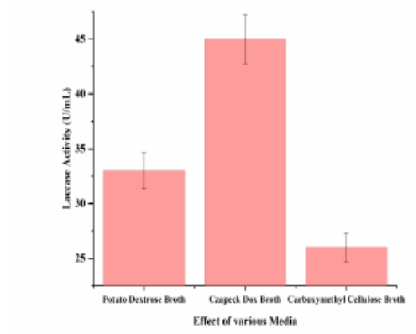


Indian Journal of Science and Technology
Year: 2023, Volume: 16, Issue: 3, Pages: 167-180
Original Article
Sabiha Naz1*, Shailendra Gupta2, Tanushree Chatterjee1
1Department of Biotechnology, Raipur Institute of Technology and Engineering, Raipur, CSVT University, Raipur, 492001, Chhattisgarh, India
2Department of System Biology & Bioinformatics, University of Rostock, Germany
*Corresponding Author
Email: [email protected]
Received Date:12 August 2022, Accepted Date:22 December 2022, Published Date:20 January 2023
Objective: To isolate an endophytic fungal laccase producer from the Ziziphus mauritiana plant leaves in the surroundings of paper mill effluents and to study its role in the decolorization of synthetic dyes, removal of COD and phenol from industrial effluents. Methods: Laccase-producing endophytic fungi were isolated and screened by using an agar plate method. The positive isolates were identified, and laccase activity was determined by using spectrophotometric methods to monitor the oxidation of guaiacol and optimizing various parameters affecting laccase production. The molecular mass of the purified laccase enzyme was determined by using 12% SDSgel electrophoresis. Industrial effluents were treated with laccase to remove phenol, decolorize dyes, and reduce chemical oxygen demand. For the analysis, a spectrophotometric method was employed. Findings: One of the most effective endophytic fungal isolates, Aspergillus oryzae, was screened as a maximum laccase producer. The optimal pH of 6, temperature of 35 oC, inoculation period of 8 days, and the inoculum number of 3 discs/100 ml of Czapek Dox Broth in submerged culture were determined for the maximum laccase production. Sucrose and sodium nitrate, as carbon and nitrogen sources, considerably assisted laccase production. The molecular weight of the isolated laccase from A. oryzae was 66 kDa. The greatest activity was determined to be 64.2 U/mL, which is two times more than under unoptimized conditions. After the fifth day of exposure, the A. oryzae laccase decolorizes the synthetic dyes Bromophenol blue, Congo red, Methyl orange, and Phenol red.Chemical oxygen demand and phenolic pollutants’ clearance rates were 38–43% and 60% from coal and textile effluents during their exposure times, respectively. Novelty: A. oryzae was discovered to be a potent natural laccase producer endophytic fungus from paper mill effluents, which may be used for decolorizing non-textile dyes, treatment of various industrial effluents, and other industrial purposes.
Keywords: Endophytic Fungi; Aspergillus oryzae; Laccase; Chemical oxygen demand; Synthetic dyes
© 2023 Naz et al. This is an open-access article distributed under the terms of the Creative Commons Attribution License, which permits unrestricted use, distribution, and reproduction in any medium, provided the original author and source are credited. Published By Indian Society for Education and Environment (iSee)
Subscribe now for latest articles and news.